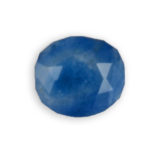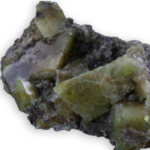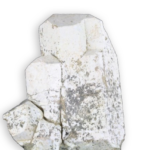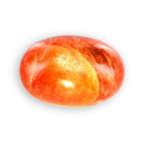
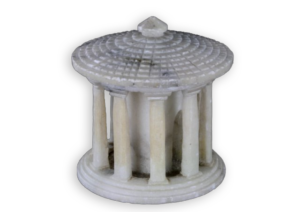
alabaster
Detailed sheet
alabaster
Its name comes from the Greek “alabastros” (earlier albatos) which designated a vase without handles, alabaster being used to make perfume vases without handles. Alabaster is an evaporite mineral.
It is a massive aggregate of fine-grained variety of gypsum, its softness make it easy to work and its attractive appearance (perfect witheness and finely grained) enable it to be carved into ornemental objects.
Since antiquity the name alabaster also referred to microcrystalline limestone, sometimes called “onyx-marble” which can be confusing.
This limestone alabaster, which is a carbonate, sometimes called Egyptian alabaster or calcite alabaster, is made of calcite or compact aragonite but is not a marble because its formation is quickier (only few years for alabaster/billions years for marble). Calcite alabaster is found as either a stalagmitic deposit, from the floor and walls of limestone caverns, it is often yellow and when broken it shows crystallized flat surface which shine, this is the reason why it seems more luminous than the gypsum alabaster.

CHEMICAL CHARACTERISTICS
Ca[SO4] 2H2O
hydrous calcium sulfate

PHYSICAL CHARACTERISTICS
Main color
white
Other colors
brown, yellow, pink
Color of streak
white
Luster
dull, silky
Hardness
2.0 to 0.0
Density
2.30 to 2.33
Cleavage
none
Fracture
granular, uneven

OPTICAL PROPERTIES
Transparency
opaque, translucent
translucent at edges or strips
Refractive index
1.520 - 1.530
Double refraction
0.010
weak
visible double refraction
No
Dispersion
0,033
Pleochroism
absent
Number of colors
1
Fluorescence
none
some alabasters can show a weak fluorescence due to impurities.

CRYSTALS PROPERTIES
compact masses, not as visible crystals.
crystals system
monoclinic

OTHER INFORMATIONS
Astrological sign
Libra, Taurus

APPROACHING GEMS
Exploited
sites
Many deposits : Germany (Thuringia), England (Derbyshire), Italy (Tuscany), United States (Colorado), and France (Parisian Basin).
use in jewelry
It has been used since antiquity to carve objects in Egypt, Middle-East, Europe and England.
The Egyptians made vassels, funerary objects such as altar and sarcophagus.
Nowadays it is used to make lotus like lamps, ornemental egges, and other ornament objetcs.
It is rarely used as jewelry because of its fragility and its porosity.
This is the 75th wedding anniversary stone.
Daily care
and precautions
Such as gypsum, alabaster is heat sensitive (when heated, gypsum turns into plaster). Alabaster made objects must be kept away from high heat sources.
Alabaster objects are cleaned with a wet cloth and Marseille soap, if the stains do not disappear, spirit of turpentine must be used to scrub gently the object, carefully because of the stone’s low hardness. After this treatment, clean the stone with soap and water to remove the grease of the spirit of turpentine and dry it with a clean cloth.
Several methods can be used to protect alabaster : coatings, waxes…microcrystalline waxes are recommended same as marbles.
imitations and
treatments
Agalmatolite, variety of the mineral pyrophyllite, looks like alabaster. Calcite and onyx marble can also be confused with alabaster.
A drop of acide allow to make the distinction between alabaster which remains practically unaffected while calcite and limestone effervesce and are dammaged.
Alabaster can be dyed.
Historical
healing properties
Must be applied to the chakra of the solar plexus, arms wide apart perpendicularly to the body, legs tight, the head oriented at north, because this stone is all centered on the cardinal points.
Its effects would be calming, providing a general feeling of well being.
Venez visitez
notre site web
voillot-joaillier.fr
Lorem ipsum dolor sit amet, consectetur adipiscing elit. Ut elit tellus, luctus nec ullamcorper mattis, pulvinar dapibus leo.Lorem ipsum dolor sit amet, consectetur adipiscing elit. Ut elit tellus, luctus nec ullamcorper mattis, pulvinar dapibus leo consectetur adipiscing elit. Ut elit tellus, luctus nec.

